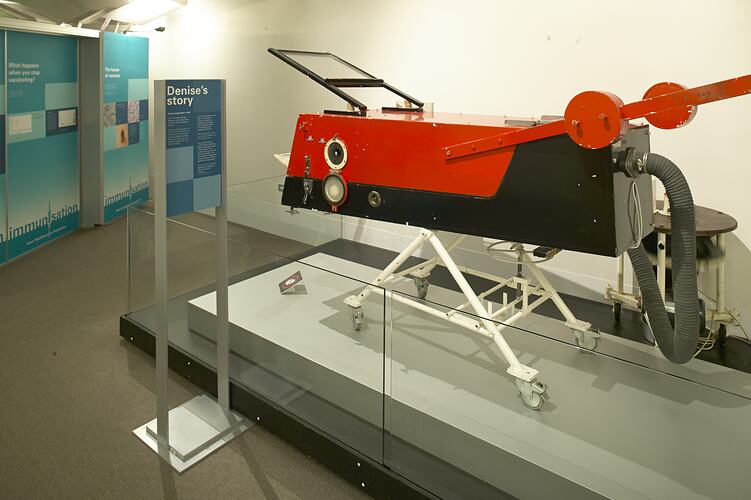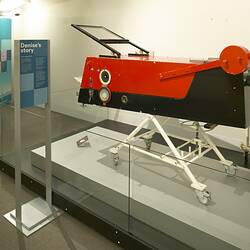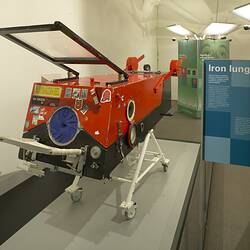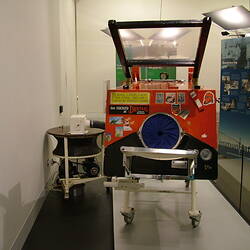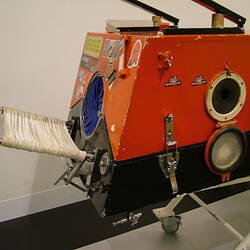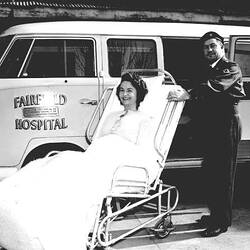Summary
Iron lung machine or respirator built at Fairfield Infectious Diseases Hospital, Fairfield, Victoria, circa 1950, and used at the hospital until around 1980.
Fairfield Hospital was the main infectious diseases hospital for Victoria, and admitted many poliomyelitis patients during the major epidemics in 1937-38 and 1949-50. Around 1950 the hospital created a specialist respirator ward to provide care for chronic patients, many suffering the after effects of polio.
This machine was used by a polyneuritis patient, whose respiratory muscles were similarly affected to those of polio patients. The box is made of wood, painted red and black after the colours of the Essendon Football Club - reflecting the interests of the patient whose home the respirator was in for many years. In a similar vein, numerous adhesive stickers, including those featuring the Essendon Bombers, have been applied to the exterior of the box.
Physical Description
This respirator consists of a wooden box painted red and black, which rests on a mobile metal frame. It is designed to be attached via a steel reinforced inlet hose, to a bellows and engine unit which delivers intermittent negative pressure to the box. Two counterweights extend beyond the rear of the box, which pivot and allow for ease of movement when raising the lid for brief access to patient, thus causing minimal loss of pressure. To maintain correct air pressure, the upper and lower half of the box is sealed with a rubber seal and two metal clamps. Within the box there is a sliding wooden base for a mattress. A metal frame supports a canvas head support. A rubber and metal seal which fits around the neck completes the air-tight containment of the patient. A wood and perspex frame folds forward from the top of the box allowing the patient to read from below. An angled mirror is attached here too, for the patient to view their surroundings. Above the box also is a pressure gauge from which positive and negative air pressure within the box can be read by an attendant. Beneath the box is an adjustable metal wheel for tilting the box, and thus the angle of the patient's chest. The original hose has been removed and replaced with a piece suitable for connecting operating pump and bellows unit.
Significance
Statement of Historical Significance:
This Iron Lung machine is one of approximately eight machines surviving in Melbourne from the last major polio outbreak in Victoria. Although this machine was used by a polyneuritis patient whose respiratory muscles were similarly affected as were polio patients, it has an important story to tell about the history of infectious disease in Victoria. The fact that it was used by a Melbourne person, a patient at Fairfield Hospital, means that it also has a local and personal story to tell - a story of a personal battle to overcome an infectious disease and the person's subsequent residual disabilities. It also demonstrates the efforts of the patient to personalise the box, soften its severity, and act as a form of self-expression beyond the limits of being identified as only a polio sufferer.
The Iron Lung draws attention to the mechanical aspects of the respiratory system, the life-depending delivery of air to the lungs, and what happens when, through disease, this system is impaired. The very immediacy and presence of the machine, with its confronting coffin-like appearance sheds light on an automatic body system which we take for granted. The viewer, putting themselves in the patient's situation, may well reflect how they might cope with the restrictions imposed from living within the confines of a box, dependent on the care of others and the continuous functioning of a machine to maintain life.
The machine draws attention to the significance of medical research and discoveries such as the Salk vaccine which has almost eradicated poliomyelitis, and thus the necessity of the Iron Lung in Australia. An added reason for acquiring this machine is that it was also manufactured and maintained locally in the Fairfield Hospital workshop, modelled on the British Nuffield design of negative pressure respirators.
More Information
-
Collecting Areas
-
Acquisition Information
Donation from Bowen Centre, Austin & Repatriation Medical Centre (A&RMC), 12 Jan 2000
-
Maker
Engineering Workshop, Fairfield Hospital, Fairfield, Greater Melbourne, Victoria, Australia, circa 1950
-
Date Used
-
Classification
-
Category
-
Discipline
-
Type of item
-
Overall Dimensions
263 cm (Length), 71 cm (Width), 131 cm (Height)
-
Exhibition Collection Management
263 mm (Length), 71 mm (Width), 131 mm (Height)
doesn't include the bellows
-
Dimensions
233 cm (Length), 73 cm (Width), 133 cm (Height)
Measurement From Conservation.
-
Keywords
Respirators, Australian Rules Football, Football Teams, Infectious Diseases, Polio (Poliomyelitis)
